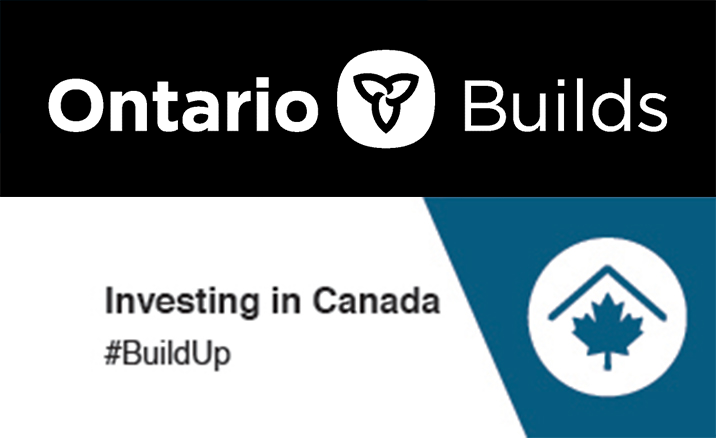
As we set out on the journey of creating our plan for the future of the Waterloo Region District School Board (WRDSB), we grounded our focus in our role of educating and preparing students to excel on their chosen path in learning and life.
The Strategic Planning Process has been, by far, the most broad consultation we have ever engaged in. We had over 10,000 participants including families, community members and partners. More than half of the participants were students from Kindergarten to Grade 12. Shaping the future of education means making students active partners in directing their educational experience. We began by prioritizing their voices, which along with their success and well-being, are at the heart of our plan. This is truly the Student’s Strategic Plan.
The WRDSB Strategic Plan will guide us towards the creation of an educational system that prepares students for success as we move towards the 22nd century – one that provides educational experiences and opportunities for all students that shape who they become as human beings and contributing members within their communities and society. As well, one that offers them the skills and knowledge needed to excel in the classroom, and for their future.
Many of the jobs current WRDSB students will hold do not exist yet. The educational foundation we create for them needs to offer them an array of skills. This will equip them to be successful wherever their life and work take them.
This means a continued and increased focus on mathematics, literacy, and supporting the development of students’ capacity for compassion, creativity, curiosity and social responsibility. Together, these skills will allow students to imagine, innovate and create a better world.
You told us how important a sense of belonging at school is for students, families and communities. To reach their full potential, students need to feel:
- Welcomed
- Supported
- Represented
- Seen
Working towards this goal begins with recognizing that our system is currently not providing these opportunities for all students. This is especially true for those who are:
- Indigenous
- Black
- Racialized
- 2SLGBTQIA+ identifying
- Have identified learning needs
- In low socio-economic living situations
In the months and years ahead, I look forward to continuing to work in close partnership with students, families and community members. You are valued partners and we cannot do this work without you. The partnership for students to achieve their highest potential must centre them. It must include students, staff and wrap around support from community partners.
I know that we need each other to address challenges, to stay focused on hope, action and optimism toward a vision where students’ identities are not predictors of outcomes. I look forward to keeping you informed about our progress in an honest, transparent and accountable way.
Hearing From You
Our collaboration on the Strategic Plan began earlier this year. You told us what mattered to you most for the future of public education in the WRDSB. We heard from more than 10,000 students, community members and staff. Importantly, more than 5,000 of those were students.
I want to thank every one of you for sharing your experiences, ideas and hopes for how public schools can better support all of those we serve. I was so happy to receive so many submissions from students across the WRDSB.
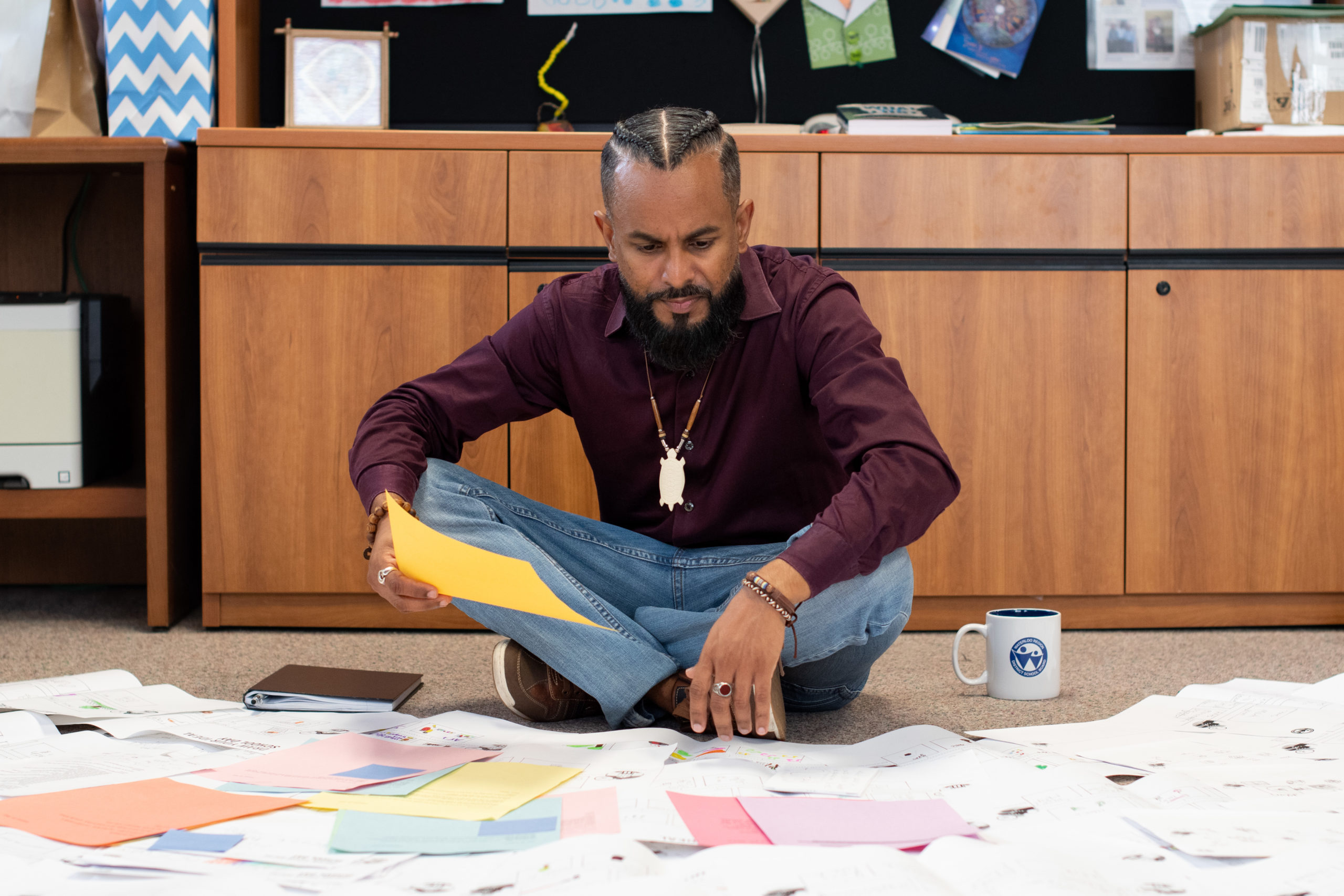
Our Strategic Plan was built using what we heard from students, staff, families and community members. It’s a plan for the WRDSB community based on what you told us.
Strategic Plan
To guide every part of our system, we have defined our vision, our mission and six strategic directions.
Our Vision
Celebrating the gifts of each and every student by creating limitless opportunities for them to flourish, grow and become their best selves.
Our Mission
Creating learning environments where all students excel as they become skilled, caring, and compassionate global citizens.
Read more about the Strategic Plan.
Strategic Directions
To begin, we spent time over the summer examining our current system structures. We have made some changes at the senior leadership level of the WRDSB to better support students and schools. This includes additional Student Support positions with a focus on student well-being and equity.
Together, they will work to support our six strategic directions:

Centring students
The voice of every student matters as we build a system to better support all we serve. Their ideas, feedback and voices will be centred as we make decisions about their education. Our organizational structures and focus will shift to ensure that students are heard and have a sense of connection and belonging at school.
Centring students includes a focus on the success of all students. This means providing increased resources and measures to support the success of Indigenous, Black, racialized and marginalized students. It means holding true to our commitments to address the Truth and Reconciliation Calls to Action.
To support this, Student Voice will be moved to the Director’s Office and it will become a shared responsibility of two superintendents who, in consultation with students, will design a model for this engagement.
Read more about centring students.
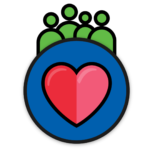
Support for student and staff well-being
As part of our mandate as a school board in Ontario, we must ensure that everyone who is part of the WRDSB feels that they belong, are included and celebrated for who they are, however they choose to show up. When students and staff can be their full selves, they can do and be their best. This means supporting every part of student and staff well-being – mental, physical, emotional and spiritual.
A student whose well-being is supported is one who can pay attention more closely in math, and one who can focus on what they’re reading for language arts. Ultimately, it allows them to unlock their full potential for academic achievement and success.
We have continued to build on existing resources and infrastructure that focuses on well-being. This year, we will create an explicit strategy around well-being that will centre staff and students.
This strategy will include piloting the new role of Student Well-being and Equity Officers. These staff will be primarily student facing and will work with students to address equity and well-being challenges that are identified by students or staff.
Read more about support for student and staff well-being.

Equitable opportunities and outcomes
We know that since public education began, identity has been a factor in determining outcomes for students. Research continues to highlight the disproportionate number of Indigenous, Black, racialized, queer, students in special education and students coming out of poverty who do not reach their full potential in school. We can change this reality by ensuring that all students have the resources, supports and opportunities they need to be successful. By providing equitable access to learning experiences for students from all backgrounds, we can help to ensure that identity is no longer a factor in outcomes for those we serve. Every student should have the chance to excel on their academic pathway.
To ensure equitable opportunities and outcomes, we will engage in de-streaming throughout the WRDSB. De-streaming is a process that begins in Kindergarten and stretches through to Grade 12 where all students learn together, instead of being grouped by ability. We will continue to focus on ensuring every student is reading by the end of Grade 2, reducing suspensions and expulsions, understanding which students are in Special Education classes and how they are succeeding, which students are attaining credits they need and who is graduating.
We will also begin to cross-reference our Student Census data to better understand students’ experiences and then transparently show how we are doing in closing achievement and well-being gaps especially as they relate to identity.
Read more about equitable opportunities and outcomes.

Strengthen connections through family and community engagement
Families and communities are partners in the education of every student we serve. In collaboration with our partners, we will define meaningful engagement and ensure that the structures of our organization support this ongoing conversation.
By engaging with families and communities, we will build healthier relationships, and create additional opportunities for partnership all with the aim of increased student academic success. Together we will help students reach their potential and become compassionate global citizens.
A new Family, Caregiver and Community Engagement Strategy will articulate what partnership and engagement means for us and the many forms it will take. We will create a new Parent engagement structure to better align the organization with the feedback from key stakeholders such as Parent Involvement Committee (PIC) and Waterloo Region Assembly of Public School Councils (WRAPSC), as well as many others we have heard from.
Read more about strengthening connections through family and community engagement.

Increase student learning through engagement
Joy, creativity and engagement are essential components of student learning. Making student learning relevant as we move towards the 22nd century is a vital part of ensuring students are engaged in their learning.
Connecting what is taught in the classroom to real-world issues and real-world skills will allow students to see the value in what they are learning in math, in language arts, or in visual arts. More engaged students perform better academically, and have a greater understanding of how what they’re learning can positively impact the world.
We will explore opportunities for inquiry-based, real-world learning that allows and affords students the opportunity to solve problems, in partnership with staff, schools and community partners who have proven experience doing this. We have seen many WRDSB students beginning to innovate and create new technology that will serve the world. Our goal for this to be the learning landscape across the entire WRDSB from Kindergarten to Grade 12.
Read more about increasing student learning through engagement.
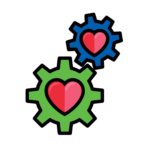
Collaboration and compassion for transformation
We cannot transform public education alone. To make this vision a reality, we will need to collaborate with the students and communities we serve. Change is hard, and there is no doubt that the path that lies ahead is not an easy one, but it is the only way to create a kinder, more compassionate and stronger public school system in Waterloo Region.
Together, we can create classrooms where every student is able to rise to their full potential in every subject area – from the physics classroom, to the art studio, to the auto shop, to gym class.
Evidence of this collaboration can already be seen in the incredible level of participation in the strategic planning process.
Read more about collaboration and compassion for transformation.
Preparing Students for the Future
Throughout the consultation process, you identified the skills and characteristics that WRDSB students need to have to be successful as we look toward the 22nd century. Based on the feedback we heard from students, families, communities and staff, this led us to the creation of a Learner Profile.
This Learner Profile focuses on who we want WRDSB students to become as they engage in learning experiences. They include being:
- Confident
- Creative and Curious
- Inclusive
- Change Makers
- Attentive to relationships
- Empathetic
- Community-oriented

Read more about the Learner Profile.
Our next steps will be to better define each of these and to think about as an organization how we understand what this means in the context of Kindergarten to Grade 12 learning. More importantly, how do we measure these so that we know students are growing in these ways?
Moving to Action
We have gone from consultation, to planning and next we move to action. As a start, we have begun to bring our purpose into sharper focus, allowing us to see our core focus more clearly. Ultimately, to do this work, we have had to pause and ask ourselves if our current structures serve these strategic directions.
This summer we spent time rethinking our hierarchical organizational structures, and reshaping them to better achieve our goals. We want to be an organization that models the aspirations we hold, so that students succeed because of us, and not in spite of us.
Our Core Focus
This is our starting point. It shows our intended key commitment in how we make our decisions through the organization. It acknowledges our partners and blurs lines to show partnerships and collaboration are necessary to make this happen.
This is not going to be an easy process because we have an organization where we want to grow to consider each and every one of our over 65,000 students. But, if students are indeed the centre and at the heart of decision making, this serves as a guide for us. Arguably, many of us do this already. However, what this signals is a commitment we will keep returning to. One that will be the basis for reflection and iterative change, and one that we hope to work with all our partners to continually improve within the constraints of the limitations that do exist for us.
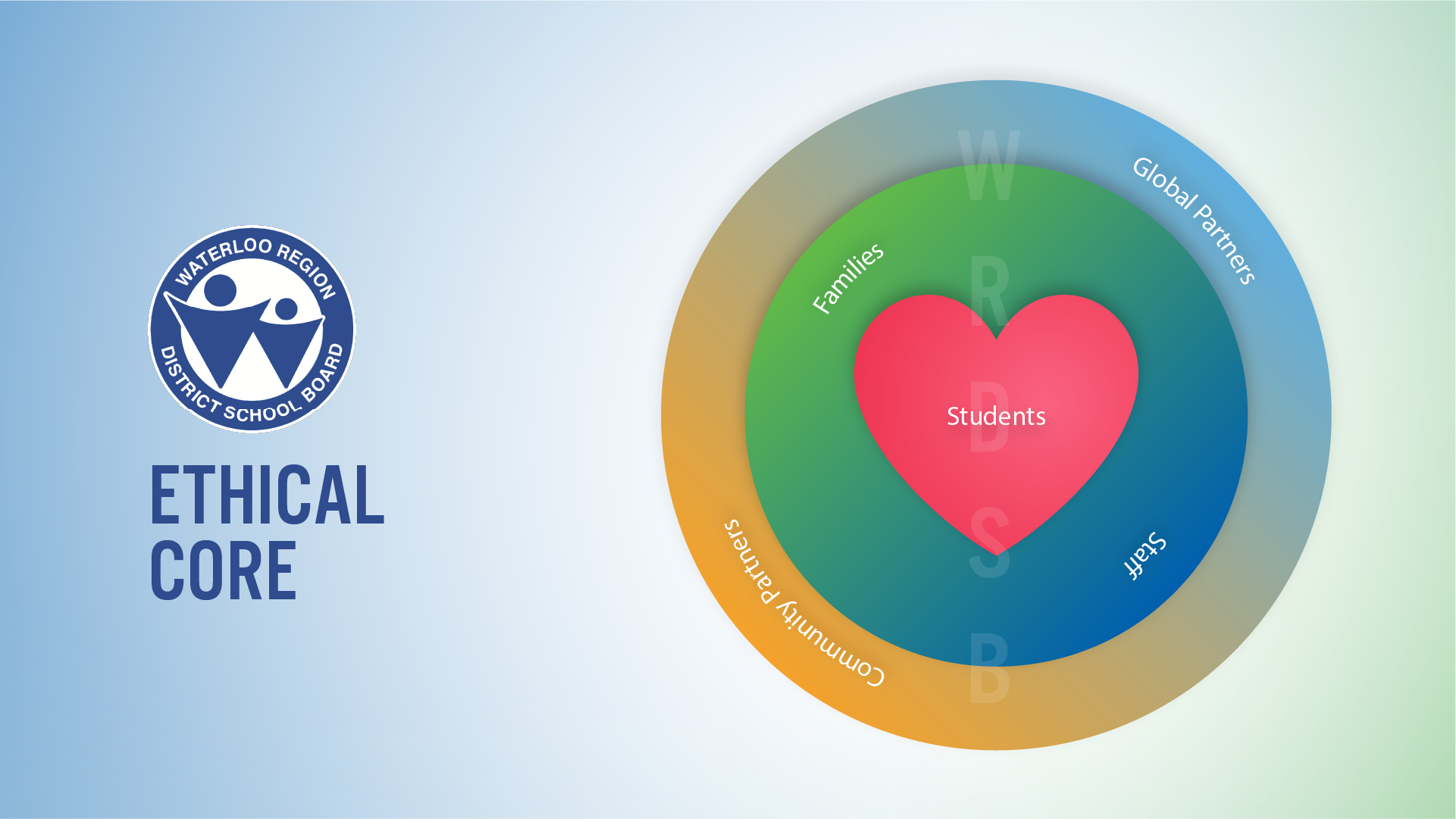
We want our structures and systems to ensure alignment through the organization. The circle represents the strength of coming together – it is anchored in the wisdom of Indigenous peoples and in many traditions around the world. We are stronger together and our collective wisdom can help us find answers that, on our own, we may not.
Our Organization
Keeping with the notion of the wisdom of the circle, we had to re-examine the hierarchical nature of our organization. There is a need for responsible leadership, however, this does not require a hierarchy. The wisdom of the circle requires us to think about how we come together at all levels to support one another in achieving the directions as they’ve been set out through broad community, staff, family and student consultations.
This new structure re-conceptualizes who is at the top of the organizational chart. It removes the director and instead places students at the top.
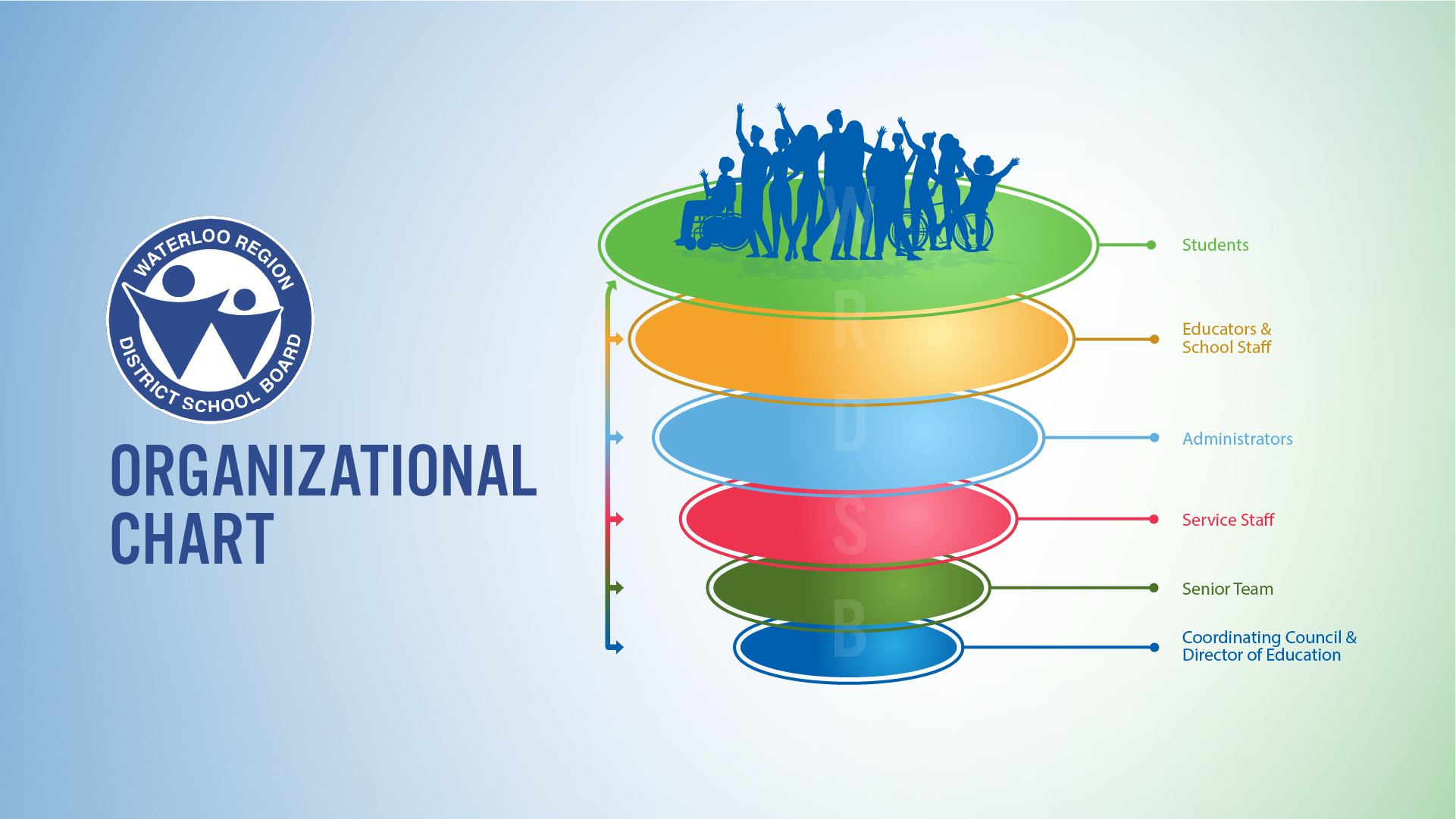
To lead is to serve. Service-based leadership means that each concentric circle is an additional layer of support starting from the bottom up, where the director and coordinating council now sits. Each circle is connected and overlaps as needed, but they get bigger as they get closer to students. The arrow at the side suggests that these circles are not static, but that people can support across the various parts of the organization, as needed, with the ultimate goal of serving students in the best possible way.
If students are at the centre of all we do, then we need to be able to engage them and ensure that student voice guides district work. We will not achieve our strategic directions if we don’t include students’ voices at all levels of the organization.
Truth and Reconciliation
In 2015, the Truth and Reconciliation Commission (TRC) finished hearing from survivors of residential schools and issued its final report and Calls to Action. In the preface of the report, commissioners stated:
“The most harmful impacts of residential schools have been the loss of pride and self-respect among Aboriginal people, and the lack of respect that non-Aboriginal people have been raised to have for their Aboriginal neighbours.”
This lack of respect manifests in a myriad of ways including lower rates of educational attainment, higher rates of poverty, and higher rates of violence and incarceration for Indigenous people. Not only do Indigenous communities contend with anti-Indigenous racism, they also must battle Indigenous erasure in the public sphere.
In the WRDSB we accept that it is our responsibility to work towards Indigenous sovereignty – the right for Indigenous peoples, here on the part of Turtle Island we today call Canada, to have self-governance and determination. We must disrupt anti-Indigenous racism and Indigenous erasure so that First Nation, Métis, and Inuit students and families have a sense of success and belonging and we recognize that the challenge of achieving reconciliation is the challenge of our time. As Senator Murray Sinclair said, “education got us into this mess, and education will get us out of this mess.”
In order to honour our commitment to achieving Truth and Reconciliation in our schools, the WRDSB is committed to ensuring students in all classrooms from Kindergarten to Grade 12 experience age-appropriate curriculum on Treaties, the contemporary and historical contributions of Indigenous peoples and residential schools. We will ensure that all students have the opportunity to build intercultural understanding, empathy, and mutual respect by learning with and about Indigenous people.
Indigenous land-based educators will work to share traditional ecological knowledge and Indigenous ways of knowing with students in our outdoor education programs. Indigenous knowledge keepers will be invited into schools so that students learn in non-appropriative ways. Teacher capacity to lead curriculum implementation will be built through a variety of summer and after school learning opportunities. Finally, to ensure that all students understand their role and responsibility in the reconciliation process, we will begin working with secondary schools in the 2022-2023 academic year to begin the transition to English: Understanding Contemporary First Nation, Métis and Inuit Voices (NBE 3) as the Grade 11 English requirement with anticipation of full implementation in the 2023-2024 school year. By making these important system-wide transitions, we will ensure that all students who graduate from the WRDSB will be able to excel as caring and compassionate global citizens and that Indigenous students see themselves reflected and celebrated in schools.
We are committed to system-wide learning about our role as settlers and guests on these territories so that we are able to move away from narratives focused on the Doctrine of Discovery and so that we can more accurately celebrate Indigenous communities as the original stewards of this land. We will understand our role as Treaty people and will understand the responsibilities we have in these reciprocal relationships. This will be a journey for us, one anchored in relationships and a commitment to continually do better. Our actions will be sovereignty-affirming so that First Nation, Métis, and Inuit students and families can fully participate and succeed in learning environments where they feel proud of their rich heritage and contributions as the original inhabitants of Turtle Island.
Black Student Success and Well-being
The Ontario Anti-Black Racism Strategy notes that:
“Black Ontarians live a shared present-day experience of anti-Black racism. The stigma and stereotypes Black Ontarians and communities face have impacted public policies, decision-making and services. As a result, in nearly every measure of opportunity, security and fairness in our society, anti-Black racism is felt.”
In the school system, this impact is measured by the numbers of Black students who are streamed out of University pathways, who are suspended or expelled from school, and who are more frequently identified as having special education learning needs, compared to their peers.
We have heard this loud and clear from not only families and caregivers of Black students, but across the entire community of staff, students and families. To better and more intentionally respond to the needs of African, Caribbean and Black identifying (ACBi) students and families, we are expanding our support for ACBi students and families by enhancing our team of System Navigators to include two community liaisons with a focus on Black brilliance and success.
We will be exploring, alongside community partners, our goal to start a Saturday Africentric focused school program for students.
We will also work with 90 of our schools over a five year period through a targeted support program that will empower schools to notice, name and disrupt anti-Black racism in our learning environments.
The program will include central professional learning opportunities for, site-based professional learning opportunities, and resource support for both educators and administrators so that all schools might better support Black brilliance. The goal is to help us learn and expand the right types of systemic changes.
We will continue to engage in system-wide learning on the ways anti-Black racism shows up throughout society and in schools with the goal of Black students being able to see and feel their identities, abilities and lived-experiences reflected through our system. We recognize that anti-Black racism pervades all systems in our society. With the support of Ministry of Education guidance, we are committed to continuing our ongoing work of creating learning environments where Black students thrive, experience joy and are successful.
As we work to support Black and Indigenous students who have historically been differentially impacted, we will be working to enhance the experience of all students.
What’s Next?
Plan in Action
Each year the Strategic Plan is broken down into a yearly operational plan which is presented to Trustees and reported back on. This year the Board Improvement and Equity Plan (BIEP), previously known as our operational plan, will be shared with Trustees near the end of 2022 and will highlight what year one of this five year plan looks like.
As required by the Ministry of Education, the BIEP outlines our plans for the school year in four key areas:
- Achievement
- Human rights and equity
- Mental health, well-being and engagement
- Transitions and pathways
Tracking Our Progress
As partners in public education, and in the success of WRDSB students, we are committed to keeping you informed about our progress towards reaching the goals set out in the Strategic Plan.
In December 2023 and each year thereafter, we will issue an annual report card based on the Strategic Plan to let you, families and community partners know what we have done. This will be an attempt to be transparent with the hope of working together to help find innovative solutions and opportunities for us to collectively do better.
There is a lot of work ahead of us, and no doubt we will face unexpected and expected challenges, too. With such an aspirational plan, we know at times we will not meet all expectations. There will be times we will miss the mark or make missteps. There are times we will deal with the realities of our limitations.
This work is hard, and necessary. I hope, though, that you will join us in the important and rewarding service of educating and preparing students for their futures. We all want to create a public education system where every student knows they belong, feels supported and is able to achieve their fullest potential in learning and in life.
Sincerely, your Partner in Education,

jeewan chanicka, director of education
Categories: Strategic Plan Tags: chanicka · Director · Director's Response · Education · jeewan · Strat Plan · Strategic Plan · Strategic Planning Process

